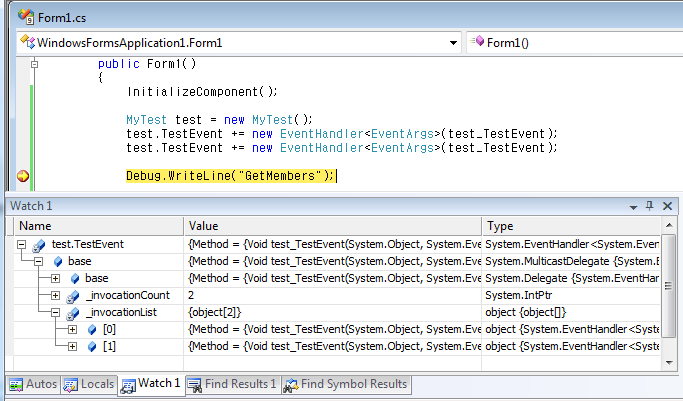이벤트에 속한 이벤트 핸들러 확인
개발하다 보면, 이벤트가 원치 않게 여러 번 불리는 것을 확인할 수 있습니다. 그래서 가끔은 해당 이벤트에 몇 개의, 어느 개체에서 이벤트를 구독하고 있는지를 알고 싶을 때가 있습니다. 사실, 이런 궁금증은 쉽게 해결될 수 있습니다. 왜냐하면, ^^ VS.NET IDE 의 디버그 창에서 이 정보들을 제공해 주고 있기 때문입니다. 예를 들어, 아래와 같이 TestEvent라는 것을 2번 구독하면 "Watch" 창에서 이벤트 구독이 2번 이뤄졌음을 확인할 수 있습니다.
[그림 1: 디버그에서 이벤트 개체 확인]

그렇다면, 이제 직접 프로그램 코드에서 확인하고 싶은 경우에는 어떻게 할 수 있을까요?
간단하지요. ^^ Reflection을 통해서 가능합니다. 오늘은, 이 과정을 한번 알아보죠!
우선, 기억을 더듬어 보면 Event 역시 내부적으로는 System.MulticastDelegate 타입의 필드로 구현이 됩니다. (기억이 희미하긴 한데, 닷넷 초기 버전에서는 효율을 위해 System.SinglecastDelegate도 있었지만 나중에 System.MulticastDelegate 하나로만 가기로 결정이 되어 역사 속으로 사라지기도 했습니다. ^^)
실제로 그런지, 다음의 코드를 통해서 알아보면,
public class MyTest
{
public event EventHandler<EventArgs> TestEvent;
}
public partial class Form1 : Form
{
public Form1()
{
MyTest test = new MyTest();
test.TestEvent += new EventHandler<EventArgs>(test_TestEvent);
test.TestEvent += new EventHandler<EventArgs>(test_TestEvent);
foreach (MemberInfo memberInfo in typeof(MyTest).GetMembers(BindingFlags.Public |
BindingFlags.NonPublic | BindingFlags.Instance))
{
string output = string.Format("{0,-20}: {1}", memberInfo.Name, memberInfo.MemberType);
Debug.WriteLine(output);
}
}
}
출력 결과는 다음과 같습니다.
add_TestEvent : Method
remove_TestEvent : Method
ToString : Method
Equals : Method
GetHashCode : Method
GetType : Method
Finalize : Method
MemberwiseClone : Method
.ctor : Constructor
TestEvent : Event
TestEvent : Field
정말로 TestEvent라는 이름의 필드가 존재하는 것을 확인할 수 있습니다. 필드 이름도 알아냈으니, 끝난 거나 다름이 없군요. "TestEvent" 필드의 값을 알아낸 후, System.MulticastDelegate로 형변환 한 다음 GetInvocationList를 호출하면 끝입니다. 간단한 설명만큼이나, 코드도 아래와 같이 매우 간단합니다.
ShowHandlerList(test, "TestEvent");
private void ShowHandlerList(object eventSource, string eventName)
{
FieldInfo fieldInfo = eventSource.GetType().GetField(eventName,
BindingFlags.NonPublic | BindingFlags.Instance);
object testEventValue = fieldInfo.GetValue(eventSource);
if (testEventValue == null)
{
Debug.WriteLine("No event handler");
return;
}
System.MulticastDelegate multicastDelegate = testEventValue as System.MulticastDelegate;
foreach (Delegate delegateFunc in multicastDelegate.GetInvocationList())
{
Debug.WriteLine(delegateFunc.Target);
}
}
==== 출력 결과 ===
WindowsFormsApplication1.Form1, Text: Form1
WindowsFormsApplication1.Form1, Text: Form1
이벤트 구독을 2번 했으니, 출력 결과에 목록이 2번 출력되었습니다. "[그림 1]"의 디버그 창에서 확인했던 값과 차이가 없습니다.
이것으로 설명 끝!
끝으로 퀴즈 하나 나갑니다. 가끔, 이벤트에 구독된 이벤트 핸들러를 모두 끊고 싶을 때가 있습니다. 마음 같아서는 "test.TestEvent = null;" 이라고 하고 싶지만, Event는 그와 같은 속성으로 사용되는 것을 허락하지 않지요. 퀴즈 문제는 바로 이겁니다. 어떻게 하면 클래스 정의 외부에서 해당 개체의 이벤트 핸들러를 모두 초기화 할 수 있을까요? (정답은,
첨부 파일의 코드에 있습니다.)
[이 토픽에 대해서 여러분들과 의견을 공유하고 싶습니다. 틀리거나 미흡한 부분 또는 의문 사항이 있으시면 언제든 댓글 남겨주십시오.]